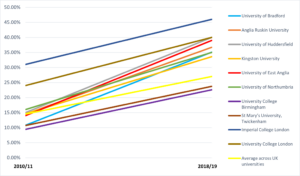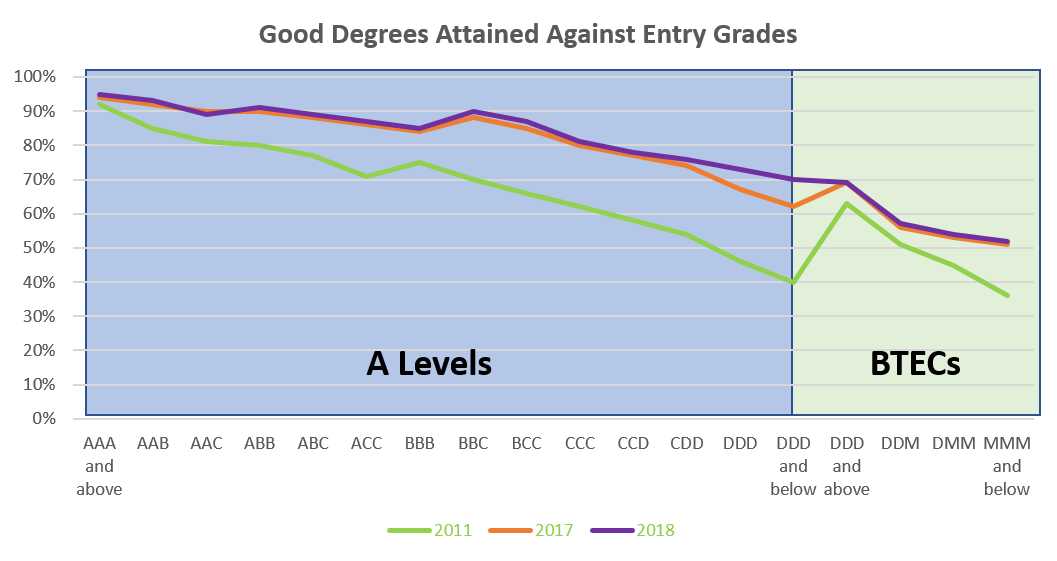Artificial Intelligence: How Grade Inflation Induces Devaluation in Intellectual Assets

Race To The Bottom
The Series: This is the second of a four-part series on university #GradeInflation; we’ll explore the evidence, the underlying causes, the defence by universities and the possible ways to resolve the problem.
This one is about the defence by universities.
The graphs in the first of this series of four articles conclusively demonstrated the extent of university grade inflation across all universities.
Although the trend had been steadily upward over a sustained period, a sharp rise in ‘good’ degrees occurred between 2010 and 2018, fuelled by the number of firsts dished out.
The top 10 universities responsible for the biggest increase in firsts are shown in the diagram below, presented in comparison to the contagious average increase across all universities in UK.

The biggest culprits, the universities of East Anglia and Huddersfield, now award firsts to around 40% of their students, just below first-leader Imperial’s 46%. The upwards overall trend in firsts’ inflation represented by the the average (in yellow) is undeniable; almost 30% of university students now attain the highest level.
The question is: would you not prefer to go to a university with a better reputation than East Anglia if you are capable of getting a first?
The Winners and The Losers
My alarm was augmented by seeing alerts on LinkedIn and hearing proud parents talking about the success of their kids. “Oh, little Jonty got a first in __________ from ________ uni.” (fill in the blanks, could be anything, could be anywhere!). Ok, so little Jonty feels good about himself, well done, and the parents feel they’ve given birth to a prodigy, but, in the bigger picture, what’s going on?

Is everyone a winner?
The universities themselves certainly seem to benefit; they’re coining it in. Not only have they experienced record numbers of paying UK and lucrative international students crossing the threshold, but the trend doesn’t look like reversing.
And, as their mesmerizingly extensive suite of undergraduate products is becoming less and less of a differentiator, more and more students are having to do the ‘panic masters’ to supplement the CV, hopefully at the same institution; this way the young people stay on the hook as a student for longer. Kerching!
This is great for businesses……the education businesses.
So then, prodigious students are gloating, proud parents are delighted, school alumni compilers are lovin’ it, uni bursars are rubbing their grubby hands, vice-chancellors are driving Range Rovers, government stats look great. Looks like everyone’s a winner.
Superficially, it might seem so….in the short-term.

Damien Hinds, remember him?, spotted the problem a while back: “Artificial grade inflation is not in anyone’s interests.” He’s gone now and, although recognising the problem, the Government intervenes in glacial ways.
What he actually meant was; there are a number of losers, in fact, pretty much everyone.
Firstly, after the initial euphoria has subsided and the insta-stories have faded, the graduates from the universities who are throwing out firsts and two-ones like confetti at a wedding feel that all their hard work and effort has been devalued by the comparable qualifications flooding the market…..artificially.
I certainly feel like that. How do you make yourself stand out now?
Companies, like Jeremy’s (my HR friend mentioned in the first article), looking to recruit graduates, are now faced with the impossible task of searching through mountains of applications adorned with stellar qualifications, not knowing if they’re any good, and how to compare History at Bath with Economics at Cardiff Met.

So, Instead, they make up new criteria, changing the goalposts in the middle of your game.
A number of sophisticated recruiters, such as EY, who are swamped with 37,000 CVs every year, are going down the road of qualification-free, ‘let’s-meet-the-real-you’, ‘blind’ CVs; if employers don’t want to look at your qualifications or don’t trust them, then Jeremy has a point and it is: ‘what’s the point?’

The thing is, inflation destroys value.
The universities would do well to heed Konrad Heiden’s observation about life in the Weimar Republic:
“At the outset, the masses misinterpreted it as nothing more than a scandalous rise in prices. Only later, under the name of inflation, the process was correctly comprehended as the downfall of money.”
It’s gonna end in tears.
But, Sir, Standards Are Higher Now
The universities fight their corner and claim that there are three main reasons for the increases in higher degrees awarded:
1. Students work harder nowadays
it’s really difficult to compare how diligent students are today compared with 40 years ago.
Back then lecturers wrote on the latest high-tech revolving blackboard with chalk. Not only did you struggle to understand the topic, but you couldn’t read the scrawl either! If you missed lectures, as I often did, you had to deal with the ramifications of triple compounding from copying up the notes from a friend with elusive calligraphy.
On a specific topic, the library would usually hold only one text which you had to book out at an anointed hour and read it fast. Networking was crucial; these were the days before the internet, so corroboration of facts usually involved chatting to a nerdy friend down the pub.
In my year there were no past papers either, so you had to make an educated guess as to what might come up. Quaint and stressful, it meant that my strongest take-aways from a ‘university education’ back in the day were that you had to be good at problem-solving and learn how to learn by yourself.
Nowadays, students have a much clearer picture of what’s expected in terms of work and desired outcome, all this is good progress, however, what comes with that is the pressure and the associated mental health problems. Awareness of the mental health support means that the back-stop of being able to retake modules and submit EC (Extenuating Circumstances) forms helps but unfortunately leads to gaming of the system.
2. Better calibre of students enter universities

Grade inflation at A level has meant that the A* grade at the top end had to be introduced to determine the top 5% of students, so it might appear that ‘higher calibre’ students are entering universities. But you’re just changing Cruzados to Cruzeiros.

In contradiction to that, there is strong evidence of a reversal of the Flynn Effect, named after the academic who found that each generation of young people had improved intellectually from the previous one up until the 1970s.
This is not just in the UK either. In addition, a study by Coe of Durham University found from standardised tests that the sort of students who got Ds and Es at A level in the late 1980s, got Bs and Cs in the mid-2000s.
Over the same period, UK students had not improved significantly on any international metric, such as the PISA, nor since.
On top of that, the Office For Students’ research, see the chart below, has found that more and more students with lower A level entry grades have been attaining good degrees over the past decade.
There has been a very clear upshift (green to purple) in candidates with lower A level grades. And yet, many schools and universities claim that a ‘C’ isn’t university currency. Drilling down, for students with two Cs and a D, the proportion of firsts rose from 14 to 21 per cent between 2014 and 2017.
Throw into the mix the fact that I hear story after heroic story of people turning it round from poor A level experience to landing a whopper at university. Don’t get me wrong, I’m all in favour of redemption tales and second chances, but we have just witnessed a huge increase in students getting two-ones and firsts with low A level grades.
The sharp improvements raise serious doubts about whether students are getting better degree results because they are higher quality. This season’s latest fashion, the must-have conditional unconditional offer, has risen to 38% of all offers, on the pretext of ‘taking the pressure off’, but looking more and more like a strategy of ‘getting bums on seats’. It all starts to look very suspicious.
3. Teaching has improved
A lot of the lectures are online these days and, from what I hear on the grapevine, most students prefer these to attending ‘in the flesh’, sardined into a lecture hall with coughing, spluttering and texting peers. I’ve viewed a number of these lectures and I don’t believe that ‘death by Powerpoint’ is a good experience nor teaching excellence.
However, ‘teaching to the exam’, nudge, nudge, wink, wink, say no more, might appear like ‘good teaching’ to the students. University should be an opportunity to listen to world-leading experts in their field talk about what they have a passion for, should it not?
Sheffield Hallam has been voted top teaching university by The Times; Professor Sir Chris Husbands, Vice-Chancellor says “… to give our students a truly exceptional learning experience. It reflects the success of our determination to respond to student feedback to drive continuous improvement.”
So then, the strategy is give the students what they want. Hallam has moved up the Guardian rankings from 85th to 55th in a few years, ‘student satisfaction’ being the rocket fuel for this propulsion.
Hold on a minute! All three of these points are unconvincing and do not seem to explain such a rapid rise
Even the Government has commented that the steep rise in grades is ‘unjustified’ and ‘unexplained’. Are there sinister forces at play?
Well, in contrast to what the universities are saying, there is strong evidence that the increase in proportion of good degree classifications in the UK may be due to: the modularisation of degree programmes, changes in assessment methods, pressures on universities to improve their league table position, or simply a reflection of a fall in educational standards. Ouch!
The universities are in a no-win situation; better grades allegedly equal higher standards and successful policy implementation, whereas reducing or static grades might look like falling standards; if that happened then you might have to do something about it and heads would roll.
This inflationary spiral suits everyone…for now.
Neil Wolstenholme, Chairman, Kloodle
In the next article, the third in this series, we’ll look at the contributory factors to this grade boom.











Responses